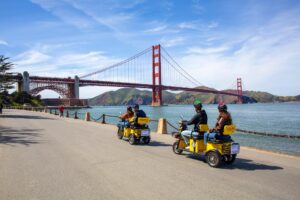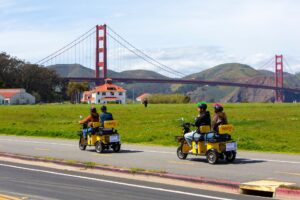The Bison of Golden Gate Park: A Tale of Survival and Calm
Visitors to Golden Gate Park in San Francisco often find themselves face to face with a surprising sight: a herd of American bison grazing peacefully in the park’s western meadow. These iconic creatures have been a cherished part of the park’s landscape since 1892. But what’s the captivating story behind the bison in Golden Gate Park? Let’s embark on a journey through history, escapes, and the park’s current herd.
A Brief History of Golden Gate Park’s Bison
Why Bison in Golden Gate Park:
Before we delve into the bison’s story, it’s essential to understand the historical context:
-
- In the 1500s, an estimated 30 to 60 million bison roamed the American prairies from northern Mexico to Canada.
- European colonization disrupted their habitat through railroads and farming, and imported cattle introduced competition and diseases.
- The most significant threat to bison was relentless hunting. Bison meat, skins, and bones were highly sought after. Notably, Buffalo Bill was a prolific hunter who contributed to the bison’s decline.
By 1889, the bison population had plummeted to about 1,000 individuals.
Fun Facts about Bison:
Before we continue, here are some intriguing facts about bison:
- Male bison can weigh up to 2,000 pounds, while females weigh around 1,000 pounds.
- In 2016, President Obama designated the American bison as the United States’ official mammal.
- Bison can use their heads as snowplows, allowing them to find food beneath deep snow.
- Due to concerns about inbreeding, many bison were bred with cows, explaining why some resemble a mix of the two.
- While “bison” and “buffalo” are often used interchangeably, they refer to different species, with buffalo native to Africa and Asia and bison specific to North America and parts of Europe.
Bison’s Arrival in Golden Gate Park:
The journey of bison in Golden Gate Park begins in the late 1800s:
- When Golden Gate Park was established, it aimed to honor the Wild West spirit, and bison were essential to this theme.
- The first bison arrived in 1891 and were initially housed in a paddock near what is now Kezar Stadium.
- The zoo initiated a captive-breeding program that successfully produced over 100 bison calves.
- Conservation efforts and growing interest in bison meat helped revive the North American bison population to hundreds of thousands.
The Current Bison Herd:
The bison currently residing in Golden Gate Park differ from the originals:
- The herd was replaced with a younger one in 1984 and again in 2011.
- In March 2020, five new bison calves were introduced to the surviving 2011 herd.
- Interestingly, all the bison in the paddock are female, a choice made to maintain a more peaceful environment, as male bison can become aggressive, especially during breeding season.
Escapades of the Past:
Historically, Golden Gate Park’s bison were known for their escapades:
- In the 1890s, there were reports of escape attempts, but the most notable breakout occurred in December 1899 during the relocation to a more secure paddock near Stow Lake.
- A bull broke away from the path and attacked a police officer on horseback, leading to a dramatic confrontation.
- In 1918, park leaders suggested sacrificing bison for food during wartime, causing public outcry.
- In July 1924, a male bison charged through a fence, prompting a police hunt through the streets.
- Halloween night in 1940 saw an escape due to a vandal cutting the herd’s fence.
The Calm and Stable Present:
Today, the bison in Golden Gate Park’s paddock enjoy a peaceful existence:
- The current herd has not made any escape attempts since 1995.
- The Spreckels Lake paddock, where they now reside, appears to be a more suitable home.
- The herd transitioned to an all-female composition in the late 1990s, minimizing conflicts and aggression.
The Legacy Continues:
The presence of bison in Golden Gate Park is a testament to conservation efforts and the enduring fascination with these magnificent animals. The park’s bison have become an integral part of its identity, representing the spirit of the Wild West in the heart of San Francisco.
As we reflect on the bison’s journey from near extinction to a thriving population in the park, we are reminded of the importance of preserving the natural world and its incredible inhabitants. The story of the bison in Golden Gate Park is not only a historical account but also a celebration of resilience and a symbol of the enduring beauty of nature within an urban sanctuary.
Bison in Golden Gate Park: A Herd of Unique Names
The bison of Golden Gate Park not only have a rich history but also an intriguing naming tradition. Over the years, these magnificent creatures have carried monikers that reflect the times and values of the era.
In their early days, the bison were named after prominent public figures of the time. Among the original bison were notable names like Grover Cleveland, Bill McKinley, and Bill Bunker. These names mirrored the political landscape of the late 19th century.
In a twist of fate, the bison then transitioned from political titles to the royal realm of Shakespeare. For a significant period, they bore names inspired by Shakespearean characters and themes, adding a touch of literary elegance to the park.
However, it was in 1993 that the bison underwent a renaming transformation. This change was brought about by the Watchbison Committee, a Native American Advisory Committee, and the San Francisco Zoological Society. They decided to bestow the bison with Native American names, paying homage to the indigenous cultures that had lived alongside these majestic animals for generations.
Today, when you visit the bison in Golden Gate Park, you may find them bearing names that resonate with the cultural heritage and natural history of North America. This naming evolution not only reflects the evolving cultural landscape but also serves as a reminder of the deep connection between these iconic creatures and the indigenous people who revered and depended on them for centuries.







